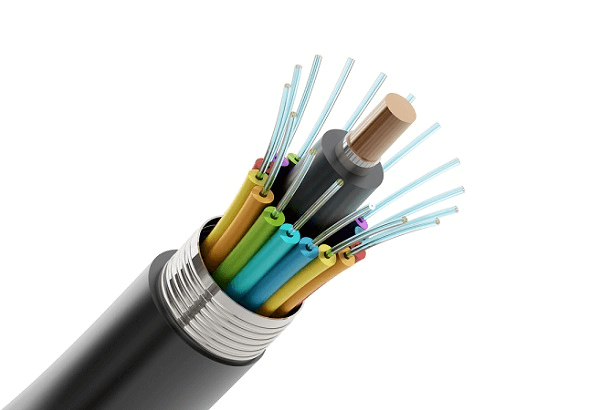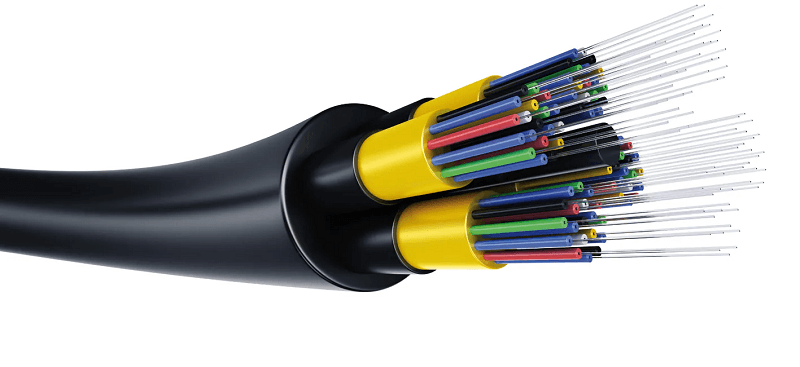Advantages and Disadvantages of Optical FiberOptical FibreIt is a data transmission method that uses a light pulse traveling down a long fiber, often constructed of plastic or glass. Companies that provide Optical fiber services are Verizon FIOS and Google Fiber Services and offer respective speeds to the customers. 
Features of the Optical Fiber
Application of optical Fibre
Different Types of Optical Fiber1. MaterialsOptical fibers have been distributed into two types based on the material usage, and they are:
Example: Core: Made of Polymethyl Methacrylate: Cladding: Done with Co-Polymer Core: Made of Polystyrene Cladding: Done with Methyl Methacrylate
Example: Core: SiO2 Cladding: Si02 Core: Ge02 Cladding: Si02 Refractive Index ProfileThey are divided into two groups according to the refractive index profile.
It has a refractive index that differs from one end of the fiber to another, which allows light rays to travel at different rates. A lower refractive index of optical fiber is present at the outer border of the object. In other words, rays on the outer edge move more quickly than at the center. Therefore, rays arrive and leave at the fiber's end almost simultaneously.
Single mode Step Index Fiber: In a single-mode step index fiber, the core is enclosed by a lower refractive index cladding than the core. Multimode Step Index Fibre: Multi-Step Index Fiber core is enclosed by cladding with a lower refractive index than the core. Plastic Optical FiberIt is a large core step-index optical fiber with a diameter of 1 mm. Optical Fiber v Copper CablesCopper wire has been the preferred choice for cable connections, telecommunications, and networking for a long period, but with a change of time, Fiber optics have emerged as the most powerful alternative to Copper. Today, most telephone companies' long distances lines have been replaced with fiber optics cables. It carries more data than the traditional copper wire due to its high speeds and large bandwidth. Working of Fiber Optics
Light particles or photons that pulse through a fiber optic cable transmit data in the fiber optics. The glass fiber and the cladding have varied refractive indices that bend the incoming light at some angle. When the light signals are released through the fiber optic cable, they reflect off the core and cladding in a series of zig-zag bounces, and it follows the principle of total internal reflection (This phenomenon arises when light beams travel from denser optical medium to less dense optical medium). Total internal reflection= sin i/sinr=n1/n2 The light waves do not move at the speed of light due to the dense glass layers; instead, they move about 30% slower than the speed of light. The fiber optics transmission cable needed repeaters at distant intervals to enhance the journey and move the signal through the travel. These repeaters generate the optical signal by turning it into an electrical signal, which then processes it into an optical signal at retransmission. Fiber cables can now support up to 10Gbps signals. Usually, the fiber's bandwidth increases with the price of the fiber increases. Top 10 Largest Optical Fiber Manufacturing Companies in India
1. Drone EdgeDrone Edge came into existence in 2010, becoming one of the most sought fiber optic cable manufacturers and exporters of Optical Fiber Cable and Joint closure and other items such as Patch chords, OLT, LIU, OTDR, and FMS. 2. Telephone Electronic CorpTelephone Electronic Corp journey from the little shop where it used to sell analog telephones to the world's most renowned institutions, including BARC Nuclear Power Plant and the Indian Army. It was formed in 1963. Being India's premier technology provider, they take immense pride in their current position in the sector. They are readily available to the consumer, whatever the conditions may be. 3. Finolex Cables LtdFinolex wires Ltd has a revenue of 26 million, one of India's most trending fiber optic cable manufacturers of communication and electrical cables. It is primarily located in Maharashtra. In the beginning, the firm began with the production of PVC-insulated electric wires to satisfy the need of the automotive sector. 4. M-CoreIt was formed in 1989, offering consumer optic fiber cable at a reasonable price. It has become a leading manufacturer, trader, and wholesaler of various products, including networking cables, CCTV wires, and electronic cables. 5. Aksh Optfiber LimitedAksh Optfiber Limited started producing optical and optical fiber cables three decades ago on Mathura Road, New Delhi. Aksh, in the year 200, purchased Optical Fiber cables as primary raw material, glass fiber reinforced plastics rods. Aksh became global in the year 2000 and registered itself on the National and Bombay Stock Exchange (BSE). Seventy percent of the optical fiber cable price comes from the two essential commodities, Fiber rod, and optical fiber. 6. Illumination Systems Pvt LtdIlluminations System Pvt Ltd offers lighting goods like LED street lamps, Fiber Optic Lighting Products, and LED interior lighting. Some of the key features include:
7. Vindhya Telelink LimitedIt is MP Birla Group flagship firm, Birla Corporation Limited, and earlier formed as Birla Jute Manufacturing and came into existence in 1919. The enterprise, under the energetic leadership of Madhav Prasad Birla, the firm, has been able to survive, compete and innovate with technological advancement and has satisfied the huge demand. Throughout the journey, the enterprise collaborated with world players and produced unique and creative goods for its consumer and the world markets. The company is based in Radisson Hotel NH-8, Mahipalpur, New Delhi, 110037. 8. Aare Telecom (p) LtdIt came into existence in 1995 and turned itself into the leading manufacturer, wholesaler, and dealer of 4 core fiber optic cable price in India tools (single and ribbon fiber), optical laser light source, optical time domain reflectometers (OTDRs), and optical signal meters. They tailored their whole line of items to meet clients' needs, such as Micro Engineers, Vodafone, and Ircone. Advantages of the Optical Fiber
Disadvantages of Optical Fiber
|
 For Videos Join Our Youtube Channel: Join Now
For Videos Join Our Youtube Channel: Join Now
Feedback
- Send your Feedback to [email protected]
Help Others, Please Share









